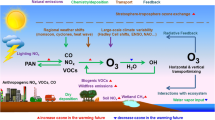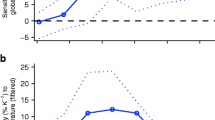Abstract
The short-term tropical surface rainfall processes in rainfall regions (raining stratiform and convective regions) and rainfall-free regions (non-raining stratiform and clear-sky regions) are investigated based on the hourly data from a two-dimensional cloud-resolving model simulation. The model is integrated over a 21-day period with imposed zonally uniform vertical velocity, zonal wind, horizontal temperature and vapor advection, and sea surface temperature from the Tropical Ocean Global Atmosphere Coupled Ocean Atmosphere Response Experiment (TOGA COARE). The analysis of the model domain-mean surface rainfall budget reveals that surface rainfall is mainly associated with water vapor convergence and local atmospheric drying. The mean surface rainfall lags the mean water vapor convergence by 3 h. The convective–stratiform rainfall separation analysis shows that convective rainfall is associated with water vapor convergence, whereas stratiform rainfall is related to the local atmospheric drying and hydrometeor loss/convergence. The transport of water vapor from rainfall-free regions to rainfall regions creates the main water vapor source for rainfall while it balances local atmospheric drying in rainfall-free regions. Surface evaporation plays a minor role in short-term surface rainfall processes.








Similar content being viewed by others
References
Chong M, Hauser D (1989) A tropical squall line observed during the COPT 81 experiment in West Africa. Part II: water budget. Mon Weather Rev 117:728–744
Chou MD, Suarez MJ (1994) An efficient thermal infrared radiation parameterization for use in general circulation model, NASA Tech. Memo. 104606, vol 3, pp 85 (available from NASA/Goddard Space Flight Center, Code 913, Greenbelt, MD 20771)
Chou M-D, Kratz DP, Ridgway W (1991) Infrared radiation parameterization in numerical climate models. J Clim 4:424–437
Chou M-D, Suarez MJ, Ho C-H, Yan MM-H, Lee K-T (1998) Parameterizations for cloud overlapping and shortwave single scattering properties for use in general circulation and cloud ensemble models. J Atmos Sci 55:201–214
Cui X, Li X (2006) Role of surface evaporation in surface rainfall processes. J Geophys Res 111, D17112. doi:10.1029/2005JD006876
Gadgil S, Joseph PV, Joshi NV (1984) Ocean-atmospheric coupling over monsoon regions. Nature 312:141–143
Gallus WA Jr, Johnson RH (1991) Heat and moisture budgets of an intense midlatitude squall line. J Atmos Sci 48:122–146
Gamache JF, Houze RA Jr (1983) Water budget of a mesoscale convective system in the tropics. J Atmos Sci 40:1835–1850
Gao S (2007) A three dimensional dynamic vorticity vector associated with tropical oceanic convection. J Geophys Res 113. doi:10.1029/2006JD008247
Gao S, Li X (2008a) Cloud-resolving modeling of convective processes. Springer, Dordrecht, p 206
Gao S, Li X (2008b) Responses of tropical deep convective precipitation systems and their associated convective and stratiform regions to the large-scale forcing. Q J R Meteorol Soc 134:2127–2141
Gao S, Li X (2010) Precipitation equations and their applications to the analysis of diurnal variation of tropical oceanic rainfall. J Geophys Res 115:D08204. doi:10.1029/2009JD012452
Gao S, Ping F, Li X, Tao W-K (2004) A convective vorticity vector associated with tropical convection: a two-dimensional cloud-resolving modeling study. J Geophys Res 109:D14106. doi:10.1029/2004JD004807
Gao S, Cui X, Zhu Y, Li X (2005a) Surface rainfall processes as simulated in a cloud resolving model. J Geophys Res 110:D10202. doi:10.1029/2004JD005467
Gao S, Cui X, Zhou Y, Li X, Tao WK (2005b) A modeling study of moist and dynamic vorticity vectors associated with 2D tropical convection. J Geophys Res 110:D17104. doi:10.1029/2004JD005675
Gao S, Ping F, Li X (2006a) Cloud microphysical processes associated with the diurnal variations of tropical convection: a 2D cloud resolving modeling study. Meteorol Atmos Phys 91:9–16
Gao S, Ping F, Cui X, Li X (2006b) Short timescale air–sea coupling in the tropical deep convective regime. Meteorol Atmos Phys 93:37–44
Gao S, Li X, Tao W-K, Shie C-L, Lang S (2007) Convective and moist vorticity vectors associated with tropical oceanic convection: a three-dimensional cloud-resolving simulation. J Geophys Res 112:D01105. doi:10.1029/2006JD007179
Grabowski WW, Wu X, Moncrieff MW, Hall WD (1998) Cloud-resolving model of tropical cloud systems during phase III of GATE. Part II: effects of resolution and the third spatial dimension. J Atmos Sci 55:3264–3282
Graham N, Barnett TP (1987) Sea surface temperature, surface wind divergence, and convection over tropical oceans. Science 238:657–659
Gutzler DS, Wood TM (1990) Structure of large-scale convective anomalies over the tropical oceans. J Clim 6:2049–2062
Johnson D, Tao W-K, Simpson J (2007) A study of the response of deep tropical clouds to mesocale processes. Part II: sensitivity tests of radiation, surface fluxes and microphysics. J Atmos Sci 64:869–886
Khairoutdinov MF, Randall DA (2003) Cloud-resolving modeling of the ARM summer 1997 IOP: model formulation, results, uncertainties, and sensitivities. J Atmos Sci 60:607–625
Krueger SK, Fu Q, Liou KN, Chin H-NS (1995) Improvement of an ice-phase microphysics parameterization for use in numerical simulations of tropical convection. J Appl Meteorol 34:281–287
Kuo HL (1965) On formation and intensification of tropical cyclones through latent heat release by cumulus convection. J Atmos Sci 22:40–63
Kuo HL (1974) Further studies of the parameterization of the influence of cumulus convection on large-scale flow. J Atmos Sci 31:1232–1240
Lau K-M, Wu H-T, Bony S (1997) The role of large-scale atmospheric circulation in the relationship between tropical convection and sea surface temperature. J Clim 10:381–392
Li X, Sui C-H, Lau K-M, Chou M-D (1999) Large-scale forcing and cloud–radiation interaction in the tropical deep convective regime. J Atmos Sci 56:3028–3042
Li T, Hogan TF, Chang CP (2000) Dynamic and thermodynamic regulation of ocean warming. J Atmos Sci 57:3353–3365
Li X, Sui C-H, Lau K-M (2002) Dominant cloud microphysical processes in a tropical oceanic convective system: a 2-D cloud resolving modeling study. Mon Weather Rev 130:2481–2491
Lin Y-L, Farley RD, Orville HD (1983) Bulk parameterization of the snow field in a cloud model. J Clim Appl Meteorol 22:1065–1092
Rutledge SA, Hobbs PV (1983) The mesoscale and microscale structure and organization of clouds and precipitation in midlatitude cyclones. Part VIII: a model for the “seeder-feeder” process in warm-frontal rainbands. J Atmos Sci 40:1185–1206
Rutledge SA, Hobbs PV (1984) The mesoscale and microscale structure and organization of clouds and precipitation in midlatitude cyclones. Part XII: a diagnostic modeling study of precipitation development in narrow cold-frontal rainbands. J Atmos Sci 41:2949–2972
Rutledge SA, Houze RA Jr (1987) A diagnostic modeling study of the trailing stratiform rain of a mid latitude squall line. J Atmos Sci 44:2640–2656
Shen X, Wang Y, Zhang N, Li X (2010) Roles of large-scale forcing, thermodynamics, and cloud microphysics in tropical precipitation processes. Atmos Res 97:371–384
Soong ST, Ogura Y (1980) Response of tradewind cumuli to large-scale processes. J Atmos Sci 37:2035–2050
Soong ST, Tao W-K (1980) Response of deep tropical cumulus clouds to mesoscale processes. J Atmos Sci 37:2016–2034
Sui C-H, Lau K-M, Tao W-K, Simpson J (1994) The tropical water and energy cycles in a cumulus ensemble model. Part I: equilibrium climate. J Atmos Sci 51:711–728
Sui C-H, Lau K-M, Takayabu YN, Short D (1997) Diurnal variations in tropical oceanic cumulus convection during TOGA COARE. J Atmos Sci 54:639–655
Sui C-H, Li X, Lau K-M (1998) Radiative–convective processes in simulated diurnal variations of tropical oceanic convection. J Atmos Sci 55:2345–2359
Sui C-H, Li X, Yang M-J, Huang H-L (2005) Estimation of oceanic precipitation efficiency in cloud models. J Atmos Sci 62:4358–4370
Tao WK (2003) Goddard Cumulus Ensemble (GCE) model: application for understanding precipitation processes, AMS meteorological monographs–cloud systems, hurricanes and TRMM, pp 107–138
Tao W-K, Simpson J (1993) The Goddard Cumulus Ensemble model. Part I: model description, Terr Atmos Oceanic Sci 4:35–72
Tao W-K, Soong S-T (1986) The study of the response of deep tropical clouds to mesoscale processes: three-dimensional numerical experiments. J Atmos Sci 43:2653–2676
Tao W-K, Simpson J, Soong S-T (1987) Statistical properties of a cloud ensemble: a numerical study. J Atmos Sci 44:3175–3187
Tao W-K, Simpson J, McCumber M (1989) An ice–water saturation adjustment. Mon Weather Rev 117:231–235
Tao W-K, Simpson J, Sui C-H, Ferrier B, Lang S, Scala J, Chou M-D, Pickering K (1993) Heating, moisture, and water budgets of tropical and midlatitude squall lines: comparisons and sensitivity to longwave radiation. J Atmos Sci 50:673–690
Tao W-K, Simpson J, Sui C-H, Shie C-L, Zhou B, Lau K-M, Moncrieff MW (1999) Equilibrium states simulated by cloud-resolving models. J Atmos Sci 56:3128–3139
Tao W-K, Shie C-L, Simpson J, Braun S, Johnson RH, Ciesielski PE (2003) Convective systems over the South China Sea: cloud-resolving model simulations. J Atmos Sci 60:2929–2956
Tao W-K, Johnson D, Shie C-L, Simpson J (2004) The atmospheric energy budget and large-scale precipitation efficiency of convective systems during TOGA COARE, GATE, SCSMEX, and ARM: cloud-resolving model simulations. J Atmos Sci 61:2405–2423
Tompkins AM (2000) The impact of dimensionality on long-term cloud-resolving model simulations. Mon Weather Rev 128:1521–1535
Waliser DE (1996) Formation and limiting mechanisms for very high sea surface temperature: linking the dynamics and thermodynamics. J Clim 9:161–188
Waliser DE, Graham NE (1993) Convective cloud systems and warm pool sea surface temperatures: coupled interactions and self-regulation. J Geophys Res 98:12881–12893
Wallace J (1992) Effect of deep convection on the regulation of tropical sea surface temperature. Nature 357:230–231
Wang J-J, Li X, Carey L (2007) Evolution, structure, cloud microphysical and surface rainfall processes of a monsoon convection during the South China Sea Monsoon Experiment. J Atmos Sci 64:360–380
Webster PJ (1994) Role of hydrological processes in ocean–atmosphere interactions. Rev Geophys 32:427–476
Weller RA, Anderson SP (1996) Surface meteorology and air–sea fluxes in the western equatorial Pacific warm pool during TOGA COARE. J Clim 9:1959–1990
Wu X, Grabowski WW, Moncrieff MW (1998) Long-term evolution of cloud systems in TOGA COARE and their interactions with radiative and surface processes. Part I: two-dimensional cloud-resolving model. J Atmos Sci 55:2693–2714
Xu K-M, Krueger SK (1991) Evaluation of cloudiness parameterization using a cumulus ensemble model. Mon Weather Rev 119:342–367
Xu K-M, Randall DA (1996) Explicit simulation of cumulus ensembles with the GATE Phase III data: comparison with observations. J Atmos Sci 53:3710–3736
Xu K-M, Cederwall RT, Donner LJ, Grabowski WW, Guichard F, Johnson DE, Khairoutdinov M, Krueger SK, Petch JC, Randall DA, Seman CJ, Tao W-K, Wang D, Xie SC, Yio JJ, Zhang M-H (2002) An intercomparison of cloud resolving models with the Atmospheric Radiation Measurement summer 1997 Intensive Observation Period data. Q J R Meteorol Soc 128:593–624
Zhang C (1993) Large-scale variability of atmospheric deep convection in relation to sea surface temperature in the Tropics. J Clim 6:1898–1912
Zhang MH, Lin JL (1997) Constrained variational analysis of sounding data based on column-integrated budgets of mass, heat, moisture, and momentum: approach and application to ARM measurements. J Atmos Sci 54:1503–1524
Acknowledgments
The authors thank Prof. M. Zhang at the State University of New York at Stony Brook for allowing us to use his TOGA COARE forcing data, and four anonymous reviewers for their constructive comments. This research is supported by the National Basic Research Program of China (973 Program) under Grant 2009CB421505, the National Natural Science Foundation of China under Grant 40775036 and 40921160379.
Author information
Authors and Affiliations
Corresponding author
Rights and permissions
About this article
Cite this article
Cui, X., Li, X. A cloud-resolving modeling study of short-term surface rainfall processes. Meteorol Atmos Phys 111, 1–11 (2011). https://doi.org/10.1007/s00703-010-0121-9
Received:
Accepted:
Published:
Issue Date:
DOI: https://doi.org/10.1007/s00703-010-0121-9




